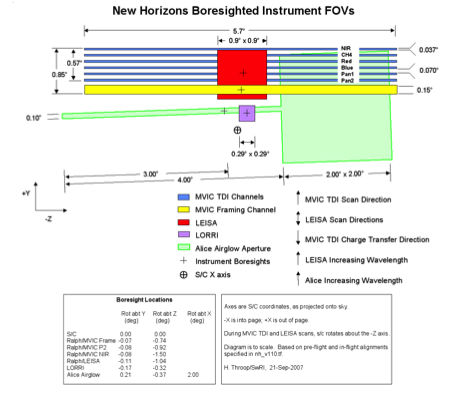New Horizons was launched at 19:00 UT (2:00 p.m. EST) on 19 Jan. 2006 on an Atlas V 551 booster with a Star 48B third stage directly into a trajectory to take it to the Pluto system and on to an encounter with a Kuiper Belt Object. In order to accomplish this, a gravity assist from Jupiter was required. For a 4-month period centered on 28 Feb 2007 a jovian observational campaign was carried out and the data were officially archived in the PDS. The flyby passed within 2.3X10**6 KM (32 jovian radii), moving at 21 km/sec. Nearest approach occurred at -8 deg. latitude, lifting New Horizons 2.5 degrees out of the plane of the solar system.
The craft is powered by a radiothermal generator (RTG) and has a 2.1 m high-gain antenna. Data from the Long Range Reconnaisance Imager (LORRI), Ralph that is composed of two parts, a visible CCD imager (MVIC) and a near-infrared imaging spectrometer (LEISA), an ultraviolet imaging spectrometer (Alice), a toroidal electrostatic analyzer and retarding potential analyzer (SWAP), a time-of-flight ion and electron sensor (PEPSSI) and the Radio Science Experiment (REX) were obtained at Jupiter.
Basic Mission Goals
Basic Goals of the NEW HORIZONS mission are to:
- Characterize the global geology and morphology of Pluto and Charon
- Map the surface composition of Pluto and Charon
- Characterize the neutral atmosphere of Pluto and its escape rate
Acquisition of data at Jupiter was an add-on.
For more information on the New Horizons Mission see the following:
Also See Space Sci Rev (2008) 140: 49–74, New Horizons Mission Design. Yanping Guo and Robert W. Farquhar
Also see Sci Rev (2008) 140: 23–47, DOI 10.1007/s11214-008-9374-8. Glen Fountain, et al., The New Horizons Spacecraft.
and
Space Sci Rev (2008) 140: 93–127. DOI 10.1007/s11214-008-9462-9, Leslie Young, et al., New Horizons: Anticipated Scientific Investigations at the Pluto System
And
Space Sci Rev (2008) 140: 75–91, DOI 10.1007/s11214-008-9376-6. H.A. Weaver, et al., Overview of the New Horizons Science Payload
Instruments and Data
Follow the instrument links above to find information about the New Horizons data products online. For a brief overview of each instrument's parameters, consult the table below.
Alice: Ultraviolet mapping spectrometer
Alan Stern, SwRI
52 - 180 nm
1.7x 70 (slit). 35 x 35 (solar occultation aperture)
1.7 x 5.2
0.183 nm
02/22/07 - 03/04/07
LORRI: Long-Range Reconnaisance Imager
Andy Cheng, APL
350 - 850nm
5.08 x 5.08
0.00496
N/A
02/21/07 - 03/07/07
Ralph MVIC: Multispectral Visible Imaging Camera
Alan Stern, SwRI
450 - 1000nm (Pan);
425 - 550nm (Blue);
540 - 700nm (Red); 780 - 1000nm (IR);
860 - 910 nm (CH4)Multicolor: 100 x N (pushbroom). OpNav, pan only: 100 x 2.6 (framing)
0.02
See filter bandpasses
02/25/07 - 03/03/07
Ralph LEISA (Linear Etalon Imaging Spectral Array): Infrared spectrometer
Alan Stern, SwRI
1250 - 2500 nm
15.9 x 15.9
0.062
Full spectral range: R=300
(~6.5 nm / pixel).
2100 - 2250 nm: R=600
(~3.7 nm / pixel).02/24/07 - 03/03/07
REX: Radio Science Experiment
Len Tyler Stanford University
4.1 cm.
20
20
Radiometry mode: N/A. Occultation mode: 3 x 10-13 in Δf/f
SDC: Student Dust Counter
Mihaly Horanyi, U. Colorado
4x10-12 - 4x10-9 g
~p
N/A
~ factor of 2 in mass
04/04/07 - 06/27/07
PEPSSI (Pluto Energetic Particle Spectrometer Science Investigation): Medium energy particle spectrometer
Ralph McNutt, APL
25 - 1000 keV (protons); 60-1000 keV (atomic ions) ;
25 - 500 keV (electrons)160 deg x 12 deg
25 x 12 deg
0.25 keV
01/05/07 - 06/20/07
SWAP (Solar Wind Around Pluto): Low energy plasma instrument
Dave McComas, SwRI
30 eV - 7.7 keV
270 deg x 10 deg (deflection angles up to +15 deg additional)
N/A
1 eV (<2 keV)
9% (>2 keV)01/07/07 - 06/19/07
Table adapted from New Horizons Mission Instrument Suite website.
ALICE is an imaging spectrometer with a spectroscopic range of 500 to 1,800 Angstroms.
RALPH consists of three panchromatic (black-and-white) and four color imagers inside its Multispectral Visible Imaging Camera (MVIC) and an infrared compositional mapping spectrometer, the Linear Etalon Imaging Spectral Array (LEISA).
REX consists of a small printed circuit board integrated into the New Horizons telecommunications system.
LORRI is a panchromatic high-magnification imager.
SWAP measures the solar wind
PEPSSI is a directional energetic particle spectrometer. It will search for neutral atoms that escape the atmosphere and become charged by their interaction with the solar
SDC is a student built dust detector.
 PDS: The Planetary Atmospheres Node
PDS: The Planetary Atmospheres Node




